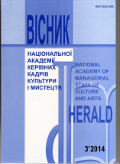ПОВСЯКДЕННІСТЬ МІСТ АНГЛІЇ: ЗА МАТЕРІАЛАМИ СЕРЕДНЬОАНГЛІЙСЬКИХ ФАБЛІО ХІІІ СТ.
Urban daily life in England according to the Middle English fabliaux of the XIIIth cent
Author(s): Oleksandr OkhrimenkoSubject(s): Cultural history, Studies of Literature, 13th to 14th Centuries
Published by: Національна академія керівних кадрів культури і мистецтв
Keywords: daily life; High Middle Ages; medieval urban space; fabliau; England;
Summary/Abstract: The period of the High Middle Ages was a basic in the process of European urbanization. During this time there was the formation of a new way of life in Europe and England. This way of life was most attractive. That is why the most people in the world now lives in cities. The British were the first urban nation.In medieval England we can investigate the characteristic features of everyday life of urban residents through original sources. Since the High Middle Ages until now remained only three anonymous works of urban literature of England of High Middle Ages written in Middle English language – "Dame Siriz", "Of the Fox and the Wolf" and "Land of Cockayne".The earliest among Middle English fabliau is "Land of Cockayne". It is conserved in a single copy, which is now found in the British Library (manuscript Harley 913, between 1250 and 1315). In the story we can separate four parts: comparison of Cockayne with the Christian Paradise; describing the country and the abbey there; the flights of monks and their shameful life; an instruction how to get to this "paradise".A very valuable resource, which is analyzed in this article, is "Dame Sirith". The manuscript of the fabliau is Digby 86 of the Bodleian library in Oxford (dates the second half of the thirteenth century). 450 lines of the poetic text narrating the adventures of Wilekin in attaining love to Margery, a wife of a merchant. This ability of Dame Siriz (neither fortune-teller, nor simply smart women) helps the hero.The fabliau "Of the Fox and the Wolf" was widely known in medieval England (written in second half of the thirteenth century). It was the English version of the story of Fox Renard. The manuscript of the humorous story is the same as the "Dame Siriz".Studying the Middle fabliaux of XIII century we discover a number of problems relating to the everyday life of townspeople of High Middle England.The features of the chronotope of everyday life of English cities during the period were accuracy and well-regulation of life. The locations of scenes in the middle English fabliaux are clear for audience, there are no necessary to characterize it. Detailing of the places leads to confusion in the "Land of Cockayne". Cities include the suburbs – the abode of monks, the outskirts of the forest, suburban roads, rivers and so on. There are no description of the walls of the city. The urban area is a part of the nature. Important elements of the space of the city was churches, cathedrals. It were described in fabliaux very vividly.In the vernacular fabliaux timeframes are conventional: "nizt and dai", "to nizt", "monizer", "monidai", "hit com to the time", "Zurstendai" and others. Calculating of the time was designated by a bell.The level of material culture of the town-livers of Medieval Albion very high. The house is very comfortable one. The daily life was concentrated around the house. That is why the subject of the fabliau focused around house too. Apartment divided into several areas – hall and rooms. Particular attention is paid to bed in the Middle English fabliaux. Obviously they covered by textiles, which also decorated the walls. This was a way for indicate a wealth of home owners, their status in society, as well as keeping a "space hygiene".A characteristic feature of the fabliaux is the lack or maximum brevity of descriptions of the characters, their clothes and so on. Obviously, the closings of the heroes are clear to the readers, listeners of viewers of fabliaux. There are the emphasis on key terms. The main features of the description of clothing in the "Land of Cockayne" are the absence of parasites; colors of clothing are clearly associated with a particular layer; luxurious textiles, silk. Also fabliaux provide materials about nudity. Apparently these indecencies are normal, natural for medieval morality. Although these erotic phenomena in medieval literature require further analysis. The feature of urban feasting of the High Middle Ages in England was the introduction of "fast food" into everyday life. The "Land of Cokayne" describes "of fleis, of fisse, and rich met, // þe likfullist þat man mei et" and "þe gees, i-rostid on þe splitte, Fleed to þat abbai, God hit wot, // And grediþ, Gees al hote, al hote!" In the system of feasting of the English bourgeoisie in the thirteenth century we view the social hierarchy. Not all products may be available equally to all people. That is why in utopia of Cockayne "man mai þer-of et inog // Al wiþ rizt and nogt wiþ wog…" Special interest medieval town-livers found in spices. And the city created the myth of "food paradise" Cokayne land, where "beþ .iiij. willis … of tereacle and halwei, of baum and ek piement".In general, the earliest examples of Middle English fabliaux offer us a vividly picture of the everyday life of medieval English towns during the High Middle Ages.
Journal: Вісник Національної академії керівних кадрів культури і мистецтв
- Issue Year: 2014
- Issue No: 3
- Page Range: 269-272
- Page Count: 4
- Language: Ukrainian

